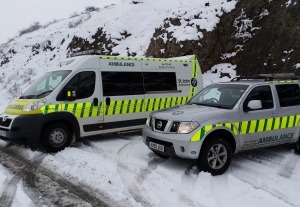St John Ambulance winter first aid advice
Date published: 13 January 2017

St John Ambulance
St John Ambulance has issued advice about how the public, especially the elderly and vulnerable, can stay safe during this winter period.
With snow and ice set to cause more injuries as people slip and fall, and others becoming ill as they are exposed to freezing temperatures, St John Ambulance, the leading first aid charity, is reminding the public how to deal with a variety of issues including: strains, sprains, and fractures; hypothermia and frostbite.
How to differentiate between strains/sprains and a fracture
Sometimes it can be hard to tell the difference between a strain/sprain and a fracture, they all can be painful, tender and swollen. If you are unable to bear weight on the limb, if there is any obvious deformity or you have any doubts about the seriousness of the injury then always seek medical advice.
How to treat a fracture
Fractures need to go to hospital, but beforehand, you should make sure the injured person is kept still and the break supported with your hands or by being bandaged (in a sling if an upper limb break, or bandaged to the uninjured leg, if a lower limb break).
How to treat a strain/sprain
- Strains and sprains should be treated initially by the RICE procedure (Rest, Ice, make Comfortable and Elevation).
- Rest - help them to sit and support their injury in a comfortable raised position.
- Ice - apply something cold. Don’t leave it on for more than ten minutes.
- Comfortable support - wrap a soft layer of padding around the area. Tie a support bandage around it which goes up as far as the next joint on each side.
- Elevation – keep the injury raised on something soft.
- If the pain is severe send them to hospital. Otherwise, tell them to rest the injury.
How to treat Frostbite and hypothermia
Frostbite and hypothermia is rare but as some areas of the country are experiencing extremely low temperatures it’s useful to be prepared and know the symptoms.
Frostbite
Frostbite happens when part of the skin and other tissues, freeze due to low temperatures. Frostbite usually affects the fingers and toes as they are the parts of the body furthest from the heart. If someone has severe frostbite, then they might permanently lose all feeling in that part of their body. Frostbite can lead to the blood vessels and soft tissues becoming permanently damaged, leading to death of the tissue and gangrene. Frostbite usually happens in freezing or cold and windy weather. People who cannot move around are more likely to get it. Someone with frostbite will probably have hypothermia, so be prepared to treat them for that too.
What to look for:
- Pins and needles’ to begin with.
- They may have numbness.
- Their skin may become hardened and stiffened.
- Their skin may be pale, and then turn blotchy and blue. On recovery, the skin may be red, hot, painful and blistered.
How to treat frostbite:
- Help them indoors, if possible, and warm their hands up by placing them under their armpits or in your hands. Don’t rub their skin.
- Place the affected part in warm water.
- Dry the area and put on a lightweight dressing. Help them raise the limb.
- Give them some paracetamol.
- Take or send them to hospital, keeping the limb raised.
Hypothermia
Hypothermia is a condition which can happen when someone’s body temperature drops below 35°C (95°F). Normal body temperature is around 37°C (98. 6°F). Hypothermia can become life-threatening quickly, so it’s important to treat someone with hypothermia straight away. Severe hypothermia, when the body temperature falls below 30°C (86°F), is often fatal. Hypothermia can be caused by being in a cold environment for a long time. The elderly, the very young, the homeless and those who are thin, frail, or not able to move around easily are particularly vulnerable.
Symptoms include:
- Shivering and pale, cold, dry skin.
- Tiredness, confusion, and irrational behaviour.
- Slow and shallow breathing.
- Slow and weakening pulse.
How to treat hypothermia:
- Get them out of the cold. If they can’t be moved indoors protect them from the cold and the elements.
- If their clothes are wet, change them and cover them with a blanket. Make sure the head is covered too.
- If they are alert give them something warm to drink and some food or chocolate.
- Call 999/112. Do not leave them alone.
- If they become unresponsive, prepare to treat someone who is unresponsive.
Do you have a story for us?
Let us know by emailing news@rochdaleonline.co.uk
All contact will be treated in confidence.
Most Viewed News Stories
- 1Failing care home shut by health watchdog following safety concerns
- 2Newhey's Char Steakhouse and Bank Chamber close with immediate effect
- 3Man charged in connection with assault on Christmas Eve in Sudden
- 4Woman of Rochdale 2024 – Lorenza Pye
- 5Two men arrested after police chase ends up in Middleton river
To contact the Rochdale Online news desk, email news@rochdaleonline.co.uk or visit our news submission page.
To get the latest news on your desktop or mobile, follow Rochdale Online on Twitter and Facebook.


